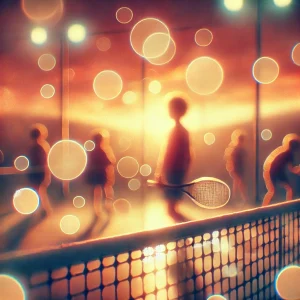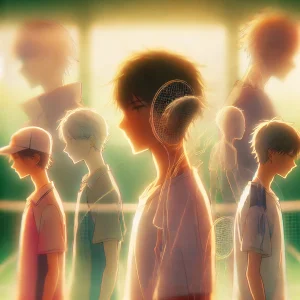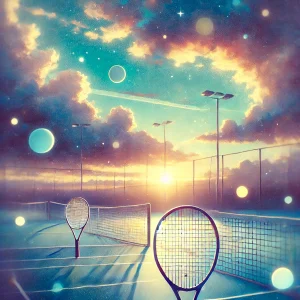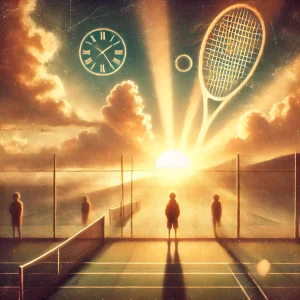Introduction to Stars Align

When you first hear about "Stars Align," you might think it's just another sports anime, but trust me, it's far from ordinary. This series dives deep into the lives of junior high school students, blending the thrill of tennis with the raw, emotional struggles of adolescence. Now, you might wonder, what makes it stand out in a sea of sports anime? Well, it’s the way it tackles real-life issues—broken families, identity crises, and the weight of expectations.
Have you ever watched a show that felt so real it hit you in the gut? That’s "Stars Align" for you. The story kicks off with Maki Katsuragi, a boy who’s reluctantly dragged into the school’s tennis club by his classmate, Toma Shinjo. But soon, you realize the story isn’t just about tennis. It’s about the battles these kids face off the court—battles that are often more intense than any match.
What’s fascinating is how the anime weaves these personal struggles into the sports narrative, creating a unique blend of drama and competition. For instance, Maki’s life isn’t easy—he deals with domestic violence and the pressure to keep it all together. But, through tennis, he finds an outlet, a way to fight back against his circumstances. And Toma, who’s determined to make the team competitive, faces his own set of challenges, including living up to his family's expectations.
The series doesn’t shy away from heavy themes. It asks tough questions about what it means to grow up, to fight for something, and to find your place in the world. But here’s the thing—it does all this without losing its sense of hope. The animation is beautiful, capturing the intensity of tennis matches and the subtleties of human emotion. And the soundtrack? It’s like the cherry on top, amplifying every moment to perfection.
Plot Summary

Let’s dive into the heart of "Stars Align." So, the story kicks off with Toma Shinjo, a passionate but struggling captain of the boys’ soft tennis team. His team is on the verge of being disbanded, and to be honest, it’s not looking good. The club’s been losing every match, and there’s zero motivation among the players. Toma knows they need a miracle, and that’s when he spots Maki Katsuragi, a new transfer student who seems like he’s got some hidden potential.
Now, Maki’s not exactly thrilled about joining a failing team, but Toma’s desperate plea—and a small cash incentive—finally convinces him to give it a shot. But here’s the twist: Maki’s life off the court is anything but easy. He’s dealing with a broken family, financial struggles, and the heavy burden of keeping up appearances. Despite all this, Maki turns out to be a natural at tennis, bringing a spark of hope to the otherwise gloomy team.
As the season progresses, the anime starts peeling back the layers of each character’s life. You quickly realize that tennis is more than just a game for these boys—it’s a lifeline. Through their interactions, we see themes of friendship, perseverance, and the harsh realities of growing up. Toma, for instance, is battling his own insecurities and the pressure to live up to his older brother’s achievements. Then there’s Rintaro, who’s dealing with issues of self-worth, and Shingo, who’s trying to find his place in a world that seems indifferent to his existence.
But it’s not all doom and gloom. The show balances these heavy themes with moments of genuine warmth and camaraderie. Watching the boys slowly come together as a team is both heartwarming and inspiring. They start to understand that winning isn’t just about scoring points—it’s about standing by each other when it counts the most.
What makes "Stars Align" truly unique is its unflinching portrayal of the personal challenges these kids face. It doesn’t shy away from tough topics like domestic abuse, parental neglect, and the struggle for identity. Yet, despite the heavy subject matter, there’s an underlying message of hope. The tennis court becomes a place where these boys can escape, even if just for a little while, from the challenges of their everyday lives.
And that’s what makes this series so compelling—it’s not just a sports anime; it’s a story about finding strength in the face of adversity and the bonds that can form even in the most unlikely of circumstances.
Character Profiles

Alright, let’s talk about the characters that make "Stars Align" such a gripping and emotional series. First up, we have Maki Katsuragi. At first glance, Maki seems like the typical quiet and reserved new kid. But as the story unfolds, we see that he’s carrying some heavy baggage. Maki’s home life is tough—he’s dealing with an abusive mother and the constant pressure to keep things together. Despite this, Maki is a natural talent when it comes to tennis. His skills on the court quickly turn him into the team’s ace, but it’s clear that tennis is more than just a sport for Maki—it’s an escape, a way to exert some control over his chaotic life.
Then there’s Toma Shinjo, the passionate and determined captain of the boys’ soft tennis team. Toma is the kind of guy who wears his heart on his sleeve. He’s fiercely loyal to his team and is desperate to see them succeed. But underneath that determination is a young boy struggling to step out of his older brother’s shadow. Toma feels the weight of expectations from his family, and that’s what drives him to push the team—and himself—so hard. His relationship with Maki is central to the story, as Toma sees in Maki the potential to turn the team’s fortunes around.
Next, we have Rintaro Futsu, the team’s mood maker. Rintaro is that friend who can lighten the mood even in the darkest of times. He’s always cracking jokes and trying to keep the team’s spirits up, but there’s more to him than meets the eye. Rintaro is also dealing with his own insecurities, particularly about his body image and his worth as a player. He’s not the best on the court, but his emotional support is crucial to the team’s dynamic.
Another key player is Shingo Takenouchi, who’s often the voice of reason among the group. Shingo is level-headed and mature for his age, but this comes from the responsibility he feels as the eldest sibling in a single-parent household. His sense of duty often puts him at odds with his own desires, but it’s also what makes him such a dependable friend. Shingo’s practical approach to life is a stabilizing force for the team, especially when things get tough.
Finally, we have Nao Tsukinose, who is perhaps the most complex character in the series. Nao is reserved and introverted, often keeping his feelings to himself. He’s an observer, always watching and analyzing those around him. Nao’s struggle with his identity and his place in the world is one of the most poignant aspects of the series. His journey towards self-acceptance is a major subplot that adds depth to the overall narrative.
These characters, with their unique backgrounds and personal challenges, are what make "Stars Align" more than just a sports anime. They’re relatable, flawed, and real, making the series a powerful exploration of youth and the struggles that come with it.
Themes and Motifs

Let’s delve into the themes and motifs that make "Stars Align" such a profound and emotionally resonant series. This anime doesn’t just tell a story about sports; it dives deep into the complexities of adolescence, family, and friendship, creating a narrative that feels incredibly real and relatable.
One of the central themes in "Stars Align" is the pressure of adolescence. Now, growing up is never easy, but this series really captures the intensity of that period in life. The characters are at a crossroads, dealing with the expectations placed on them by society, their families, and even themselves. Take Toma, for example. He’s constantly trying to prove himself, not just on the tennis court but also in the eyes of his family. He’s chasing his brother’s shadow, and that weight is almost too much for him to bear. Maki, on the other hand, is dealing with a different kind of pressure—the need to survive in a home where love and safety are in short supply. These kids are trying to find their place in the world, and the series doesn’t shy away from showing just how hard that can be.
Family dynamics is another powerful motif that runs throughout the series. Each character has a unique family situation that shapes who they are and how they see the world. For Maki, his relationship with his abusive mother is a source of constant pain and anxiety. It’s heartbreaking to watch, but it’s also a stark reminder of how much our families can impact us, for better or worse. Then there’s Toma, who feels the need to uphold his family’s reputation, often at the expense of his own happiness. The series paints a vivid picture of how complicated and messy family life can be, and how those dynamics play a crucial role in the characters’ development.
But amidst all the struggles and hardships, friendship emerges as a beacon of hope. The bonds that form between the members of the tennis team are at the heart of "Stars Align." These boys come from different backgrounds, each carrying their own burdens, yet they find solace in each other’s company. It’s in these friendships that they find the strength to keep going, to push through their personal challenges. The series beautifully illustrates how friendship isn’t just about having fun together; it’s about being there for each other, especially when things get tough. This theme is woven into every episode, reminding us of the importance of connection and support during difficult times.
Another interesting motif is the idea of identity and self-discovery. The characters in "Stars Align" are all trying to figure out who they are and where they belong. Nao’s journey, for instance, is deeply tied to his struggle with identity. He’s quiet and reserved, often feeling out of place, but through his interactions with the team, he begins to explore who he is and what he wants. This theme of self-discovery is something that many viewers can relate to, making the series not just a story about tennis, but a story about life.
Reception and Impact

Let’s talk about how "Stars Align" was received by both audiences and critics, and the impact it had on the anime community. When "Stars Align" first aired, it quickly gained attention for its unique approach to storytelling. It wasn’t just another sports anime; it was something more—something deeper. Viewers were drawn to its realistic portrayal of the struggles faced by young people, and this resonated with many, especially those who could see parts of themselves in the characters.
Critics praised "Stars Align" for its boldness in tackling heavy and often uncomfortable topics like domestic abuse, gender identity, and mental health. These are not themes you typically see explored with such depth in a sports anime, and that’s precisely what made this series stand out. The show’s willingness to address these issues head-on earned it a reputation as a thought-provoking and emotionally charged narrative.
However, the reception wasn’t all smooth sailing. The sudden and unexpected cancellation of the series left many fans heartbroken and frustrated. Originally planned as a two-cour series, "Stars Align" was cut short, ending abruptly with only 12 episodes. This decision led to an outcry from the community, with fans expressing their disappointment and longing for the continuation of a story that had deeply moved them. Social media was abuzz with petitions and campaigns urging the production team to bring back the series, but unfortunately, the second cour never materialized.
Despite the abrupt ending, "Stars Align" managed to leave a lasting impact. It sparked important conversations within the anime community about the representation of real-world issues in media and the power of storytelling to evoke empathy and understanding. The series also influenced discussions around the expectations placed on anime creators and the challenges they face in delivering complete narratives within the constraints of the industry.
Moreover, "Stars Align" found a dedicated fanbase that continues to celebrate its message and artistry. The show’s impact can be seen in the way it has inspired fan art, essays, and even fan fiction, with creators exploring the storylines that were left unresolved by the series’ early conclusion. This ongoing engagement is a testament to the emotional connection that "Stars Align" fostered among its viewers.
In the end, "Stars Align" is remembered not just for the story it told, but for the conversations it started. It challenged the norms of what a sports anime could be and pushed the boundaries of the genre, making a significant mark on those who experienced it.
